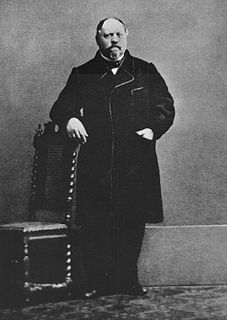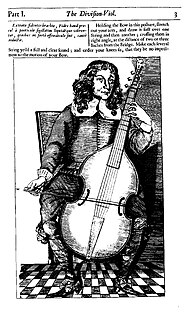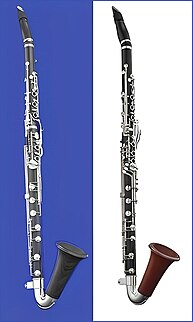
The clarinet is a family of woodwind instruments. It has a single-reed mouthpiece, a straight, cylindrical tube with an almost cylindrical bore, and a flared bell. A person who plays a clarinet is called a clarinetist.
Johann Christoph Denner was a German woodwind instrument maker of the Baroque era, to whom the invention of the clarinet is attributed.

The basset clarinet is member of the clarinet family similar to the usual soprano clarinet but longer and with additional keys to enable playing several additional lower notes. Typically a basset clarinet has keywork going to a low (written) C or B, as opposed to the standard clarinet's E or E♭. The basset clarinet is most commonly a transposing instrument in A, although basset clarinets in C and B♭ and very seldom in G also exist. The similarly named basset horn is also a clarinet with extended lower range, but is in a lower pitch ; the basset horn predates, and undoubtedly inspired, the basset clarinet.
A clarinet concerto is a concerto for clarinet; that is, a musical composition for solo clarinet together with a large ensemble. Albert Rice has identified a work by Giuseppe Antonio Paganelli as possibly the earliest known concerto for solo clarinet; its score appears to be titled "Concerto per Clareto" and may date from 1733. It may, however, be intended for soprano chalumeau. There are earlier concerti grossi with concertino clarinet parts including two by Johann Valentin Rathgeber, published in 1728.

Hyacinthe Eléonore Klosé was a French clarinet player, professor at the Conservatoire de Paris, and composer.

A soprano clarinet is a clarinet that occupies a higher position, both in pitch and in popularity, than subsequent additions to the family such as the basset horn and bass clarinet. The B♭ clarinet is by far the most common type of clarinet and the unmodified word clarinet usually refers to this instrument. However, due to a tendency for writers and historians to imitate the terms used to denote instruments in other instrumental 'family groups' the term soprano is sometimes used to apply not only to the B♭ clarinet but also to the clarinets in A and C, sounding respectively a semitone lower and a whole tone higher than the B♭ instrument, and even the low G clarinet—rare in Western music but popular in the folk music of Turkey—sounding a whole tone lower than the A. While some writers reserve a separate category of sopranino clarinets for the E♭ and D clarinets, those are more usually regarded as soprano clarinets as well. All have a written range from the E below middle C to about the C three octaves above middle C, with the sounding pitches determined by the particular instrument's transposition.
Salvador Bacarisse Chinoria was a Spanish composer.

Buffet Crampon SAS is a French manufacturer of wind instruments based in Mantes-la-Ville, Yvelines department. The company is the world market leader in the production of clarinets of the Boehm system. Its subsidiary, Buffet Crampon Deutschland GmbH, founded in 2010 and based in Markneukirchen, Vogtland, Sachsen, is the world market leader in the manufacture of brass instruments. To manufacture and sell its products, the BC Group employed around 1000 people worldwide at the beginning of 2021, 470 of them as employees of BC Germany alone. The management of the group has been in the hands of Jérôme Perrod since 2014.

The flageolet is a woodwind instrument and a member of the fipple flute family which includes recorders and tin whistles. Its invention was erroneously ascribed to the 16th-century Sieur Juvigny in 1581. There are two basic forms of the instrument: the French, having four finger holes on the front and two thumb holes on the back; and the English, having six finger holes on the front and sometimes a single thumb hole on the back. The latter was developed by English instrument maker William Bainbridge, resulting in the "improved English flageolet" in 1803. There are also double and triple flageolets, having two or three bodies that allowed for a drone and countermelody. Flageolets were made until the 19th century.

The A-flat clarinet is a member of the clarinet family, smaller and sounding a perfect fourth higher than the E♭ clarinet. The A♭ is rare, but even less common, obsolete instruments in high C, B♭, and A♮ are listed by Shackleton. Some writers call the A♭ and these other instruments octave clarinets, sopranino clarinets, or piccolo clarinets. The boundary between the octave and soprano clarinets is not well-defined, and the rare instruments in G and F might be considered as either. Shackleton, along with many early twentieth-century composers, uses the term "piccolo clarinet" to refer to the E♭ and D clarinets as well. This designation is less common today, with the E♭ and D instruments more usually designated soprano clarinets. The term "piccolo clarinet" is used by some recent music software for the A♭ clarinet.

Besson is a manufacturer of brass musical instruments. It is owned by Buffet Crampon, which bought Besson in 2006 from The Music Group.

The Boehm system for the clarinet is a system of clarinet keywork, developed between 1839 and 1843 by Hyacinthe Klosé and Auguste Buffet jeune. The name is somewhat deceptive; the system was inspired by Theobald Boehm's system for the flute, but necessarily differs from it, since the clarinet overblows at the twelfth rather than the flute's octave. Boehm himself was not involved in its development.

Acis et Galatée is an opera by Jean-Baptiste Lully. Unlike most of his operas, which are designated tragédies en musique, Lully called this work a pastorale-héroïque, because it was on a pastoral theme and had only three acts compared to the usual five. Otherwise, there is little musically or dramatically to distinguish it from Lully's tragédies.

The division viol is an English type of bass viol, which was originally popular in the mid-17th century, but is currently experiencing a renaissance of its own due to the movement for historically informed performance. John Playford mentions the division viol in his A Brief Introduction of 1667, describing it as smaller than a consort bass viol, but larger than a lyra viol.

The clarinet family is a musical instrument family including the well-known B♭ clarinet, the bass clarinet, the slightly less familiar E♭ and A clarinets and other clarinets.
Johann Heinrich Wilhelm Grenser was a German musical instrument maker.
The Académie de Poésie et de Musique, later renamed the Académie du Palais, was the first Academy in France. It was founded in 1570 under the auspices of Charles IX of France by the poet Jean-Antoine de Baïf and the musician Joachim Thibault de Courville.
The Blanchet family were an extended family of French harpsichord-makers from the late-17th century to the mid-19th century, by which time they had become piano makers.
Marigaux, also known as SML (Strasser-Marigaux-Lemaire) is a French manufacturer of high quality woodwind musical instruments.

Schwenk & Seggelke, is a German clarinet manufacturer based in Bamberg in the Bavarian Upper Franconia. The company manufactures clarinets according to the German handle system and the French system as well as in a combination of both systems, starting from the Boehm system. A specialty of the company is the reproduction of historical clarinets.












